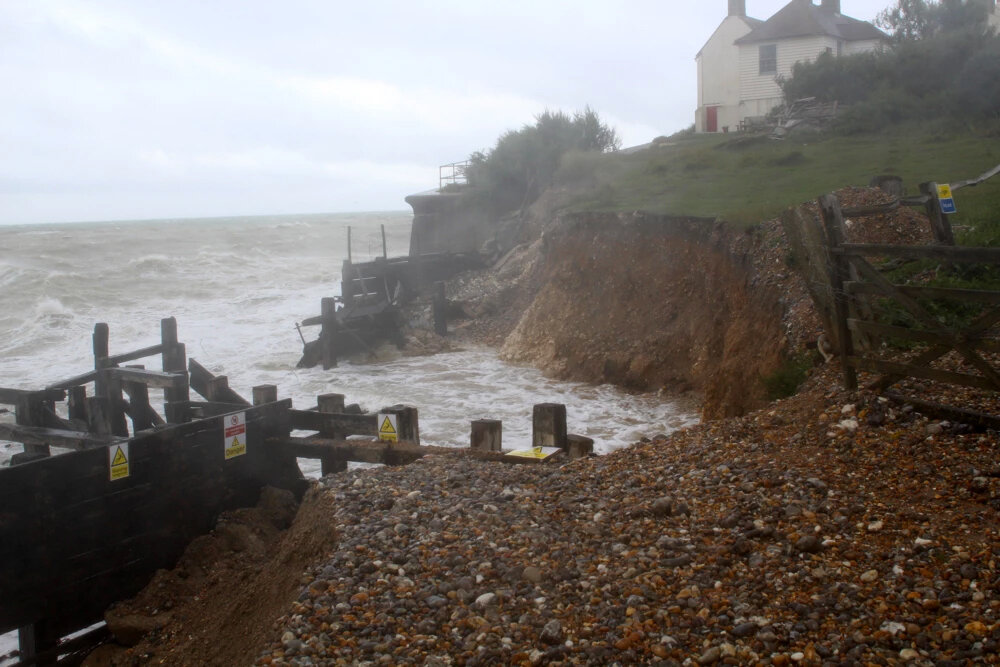
The details
What’s happened
The power of nature and a lack of resources to provide adequate protection against our increasing storms has led to ongoing destruction of the existing sea defences. This has left the landscape and coastguard cottages vulnerable to the elements.
“Over one third of the land area below the Cottages has been swept away.”
Cuckmere Haven experienced a series of exceptionally severe storms which resulted in serious destruction and erosion of the West Beach coastal defences, the public access to the beach, and put the lower coastguard cottage at risk. Over one third of the land area below the cottages has been swept away in the last hundred years.
The powerful swirling waves undermined the groynes allowing tons of shingle and soil to be sucked out to sea and creating a huge pit 50 X 70 metres. The concrete surrounding the metal barriers was fractured and groynes destroyed.
The cables laid in 1900 from the Cuckmere cable hut to France were all that held the footpath to the beach in place as the eddies carved out a cave 3 metres in depth underneath.
Attempts to stop the destruction were only swept away by the next storm. It became apparent that only major work would do the job.
“A major engineering firm quoted between £250,000 to £400,000 just to stop the destruction from the beach.”
There have been huge storms in the past and any damage was rectified by the Environment Agency. However the storms are now much more frequent and the government declared they would no longer finance any repairs but are going to allow the sea to take its course - and the landscape with it.
The cottage owners and volunteers have to take on the responsibility and fund the work themselves. They have done this in the past but not on such a large scale.
Failure to keep the groynes in good repair has allowed the shingle to be swept eastward away from their protective position in front of the cottage defences. At the same time, the long breakwaters on each side of Seaford Bay keep the shingle from being replaced from the west.
Engineers were consulted and surveys done. A major engineering firm quoted between £250,000 and £400,000 just to stop the destruction from the beach. Of course this was beyond the means of the supporters.
After the August storm all existing sea defences were destroyed. It became evident that with the winter approaching something had to be done.
A plan was drawn up with a local firm to hold the sea back on a temporary emergency basis. Cranes worked from 16th of September 2014 to 16 October 2014 moving rock found on the shore to an area that had been the weakest spot. This had been caused by groynes having been put at right angles thus causing the force of the waves to swirl and eddy eating away at the hillside.
The land behind the old revetment was dragged out by the power of the sea, so it was filled with 400 tons of granite.
A new barrier was constructed to deflect the sea from eating away at the hillside that led to the cottages.
Giant Lego type concrete blocks were used to brace the outer old metal sea defence wall.
Government policy
Although The Environment Agency cannot carry out the defensive work to protect this magnificent landscape, we are allowed to as long as we obtain all the necessary permissions from the South Downs National Park, Natural England, The Environment Agency and others.
Government policy is to allow natural processes to prevail on this stretch of coastline, which could well mean gradual or sudden coastal retreat.
Protecting this site can't be funded by central government.
Although the funds, expertise and effort required to secure this historic site are not insurmountable, the cost of protecting Cuckmere Haven has become greater than local pockets can afford.
“...policy for this area is for No Active Intervention.”
Cuckmere Haven – policy unit 4d.03 :
"The medium and long term policies within the SMP2 were for No Active Intervention following the Managed Realignment of the first epoch. The subsequently adopted Strategy policy for this area is for No Active Intervention immediately: Notice of Withdrawal of Maintenance has already been served. Whilst this is a change of policy it is more a bringing forward of policy."
Please see:
What needs to be done
To maintain the existing sea defenses against further erosion and outflanking for decades to come, two options have been considered.
Failure to maintain the existing defences will result in their piecemeal collapse, followed by erosion of the soil, slopewash and weathered chalk, with the eventual loss of this historic landscape
All around our shores there are stretches of coast where the sea is encroaching and land and homes are being lost. It is too easy to say that in certain situations nothing can be done to hold back the sea. For nearly 70 years the cliffs and cottages at Cuckmere Haven are a good example of how this can be done. The cliff on which the Coastguard Cottages were built in the 1830s was being seriously eroded at the end of WWII. To check this erosion the cottage owners used war reparation money to build the large retaining sea wall, still highly visible today.
Between 1947 until 2014 further work on the defences was undertaken on seven occasions, at considerable expense to the cottage owners. The severe storms of 2013/14 meant some emergency engineering work was necessary to protect the lower cottages and the historic cable hut from being taken by the sea.
This famous site across the river from the Seven Sisters has survived for 70 years thanks to the vigilance and prompt action of the cottage owners and preserved the views that we all enjoy. The time has come to make use of current knowledge and technology to ensure that this landscape remains safe for many more years to come.
Phases 1, 2 and 3: Option 1
Phase one as pictured, will cost in the region of £200,000. This work will ensure the survival of this priceless location for many years to come.
Phase two below the lower two cottages will consist of constructing a low concrete defence strip at the foot of the existing large wall to stop further undermining from wave action.
Phase three below the top two cottages is to continue the low-level sheet piling along the toe of the concrete wall.
Option 1
The most effective way of dispersing the immense power of storm waves is with a substantial ramped wall of massive rocks - 4-5 tons each. There are two problems with this scheme . First, the rocks would most likely have to be sourced in Norway or France and shipped by barges to Cuckmere Haven and the expense would be enormous. Secondly, The coastline at Cuckmere Haven has been recently designated as a Marine Conservation Zone, which means there should be no unnatural disturbance to the beach and shore platform in the intertidal zone. The moving of thousands on tons of rock to the area by sea would cause environmental impact and be visually intrusive.
Option 2
The second and less intrusive option would consist of a line of low level sheet piling driven into the chalk along the toe of the existing piling which is showing signs of disintegration. Concrete would be used to fill the gap between the old and new walls. Pilings would have minimal impact on the Marine Conservation Zone. It would follow a curving line to a point just north-east of the Cable Hut, where its top would be at ground level. The pilings would be deep enough to stop the undermining action of the waves.
Campaign:
The details | In the media | Support

















